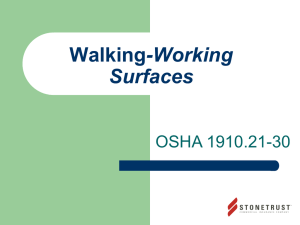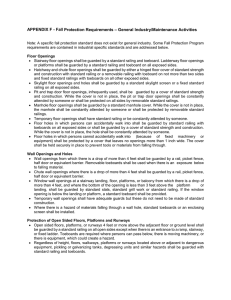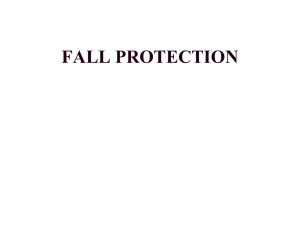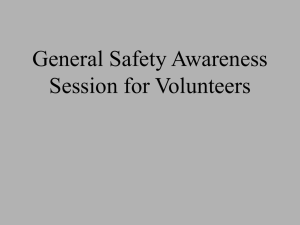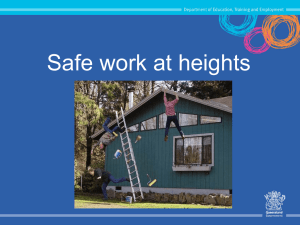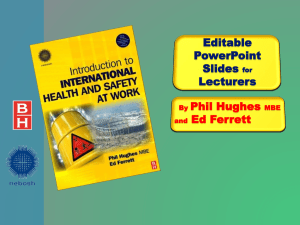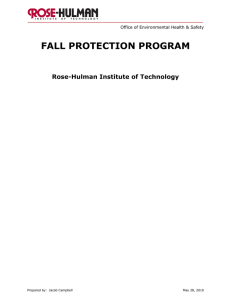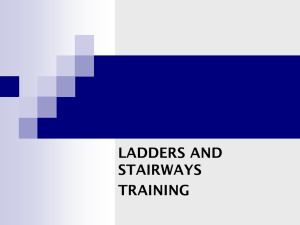ifp
advertisement
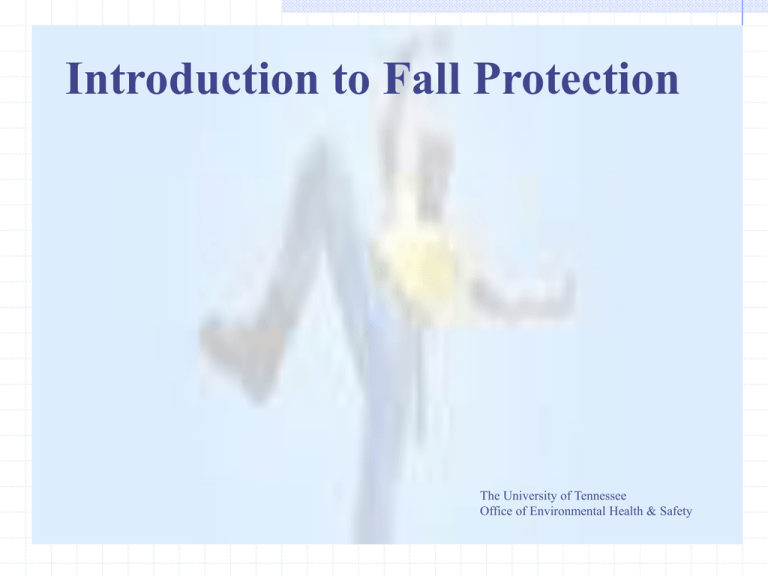
Introduction to Fall Protection The University of Tennessee Office of Environmental Health & Safety What is Fall Protection? Fall Protection from an Historical Perspective “When one falls, it is not one’s foot that is to blame.” - Chinese proverb For thousands of years man has used ropes and various knots to help or secure objects against the forces of gravity. Some of the earlier users could be found on sailing ships, in church steeple construction and maintenance, and in treetrimming trades. The use of ropes and some type of body belt for restraint or work positioning support found particular interest during stormy seas and above the decks of ships. I have always been told, “It’s not the fall that hurts you – it’s that sudden stop.” Physics of a Fall A body in motion (free fall) can cover vast distances in a short period of time. Consider this: A body in free fall can travel 4 ft in 0.5 seconds A body in free fall can travel 16 ft. in 1 second A body in free fall can travel 64 ft. in 2 seconds Physics of a Fall Think of it this way: a. We have a sports car that can go from 0 to 60 mph in 4.7 sec. b. You fall from an elevation 0 to 60 mph in 3.0 sec. Guess what? YOU WIN! It takes an average person ¾ of a second to react! In ¾ of a second you have fallen 10 feet. Now, are you ready for sky diving? Slips, Trips and Falls on same Level and from Elevation Slips, Trips and Falls Fall related injury reports related to falls are commonly reported as a slips, trips and falls. These are then divided into two groups: Falls on same level and falls from elevation. Of all reported, falls from the same level are the most common. Statistics •Falls 33% •Struck By 18% •Electrical 17% •Caught In 18% Statistics •Falls are the number one cause of fatalities in the construction industry. •150-200 workers are killed each year and more than 100,000 injured as a result of falls. •Overall (including general industry) falls are the number two biggest cause of fatalities in the U.S. (motor vehicle accidents are number one). The highest mortality rate is falls from roofing followed by structure and then catwalks with ladders a close fourth. What can I do to prevent falls? What can I do to prevent falls? 1.Take time to inspect the work area, note hazards and eliminate if feasible. a.Engineering control – redesign – install guards, rails, cover open holes. b.Maintain good housekeeping. c.Establish a fall protection system. General Requirements Housekeeping Workplaces must be kept clean, orderly, and sanitary Workroom floors must be maintained as clean and dry as possible General Requirements Aisles and Passageways 1. Keep clear and move obstructions that could create a hazard 2. Mark permanent aisles and passageways 3. Aisles must be sufficiently wide where mechanical handling equipment is used General Requirements Covers and Guardrails Provide covers and/or guardrails to protect workers from the hazards of open pits, tanks, vats, ditches, and the like. Floor Opening An opening measuring 12 inches or more in its least dimension in a floor, platform, pavement, or yard, through which persons may fall. Floor Opening FLOOR OPEN MUST BE GUARDED! Standard railing. Consists of top rail, mid rail, and posts. Height from the upper surface of top rail to floor level is 42 inches. Mid rail height is 21 inches. Standard toeboard. 4 inches high, with not more than ¼-inch clearance above the floor. Stairway Floor Openings Must be guarded by a standard railing on all exposed sides (except at entrance). Ladderway Floor Openings Guard with a standard railing with toeboard on all exposed sides (except entrance) Guard the passage through the railing with a swinging gate or offset it to prevent someone from walking into the opening Example: Drywell access, pipe chase, etc. Floor Hole An opening measuring less than 12 in. but more than 1 in. in its least dimension, in a floor, platform, pavement or yard, through which materials but not persons may fall. Floor Hole Every floor hole into which persons can accidentally walk must be guarded by either: 1. Standard railing with toeboard 2. Cover Wall Openings Opening at least 30 in. high and 18 in. wide, in a wall or partition, through which persons may fall. In addition: wall openings from which there is a drop of more than 4 feet must be guarded. Open-Sided Floors and Platforms Open-sided floors or platforms 4 feet or more above adjacent floor or ground level must be guarded by a standard railing (or equivalent) on all open sides, except where there is an entrance to a ramp, stairway, or fixed ladder Open-Sided Floors and Platforms A toeboard is required when, beneath the open sides: a person can pass; there is moving machinery, or there is equipment with which falling materials could create a hazard. Regardless of height, a standard railing and toeboard must be used to guard: - open-sided floors - walkways - platforms, or - runways above or adjacent to dangerous equipment, pickling or galvanizing tanks, degreasing units, and similar hazards. Stairways Flights of stairs with four or more risers must have standard stair railings or handrails. Portable Ladders 1. Ladders used to gain access to a roof or other area must extend at least 3 feet above the point of support. 2. Withdraw defective ladders from service and tag or mark "Dangerous, Do Not Use“ 3. Never use ladders in a horizontal position as scaffolds or work platforms 4. Never use metal ladders near electrical equipment Ladder Angle Portable Rung and Cleat Ladders Use at angle where the horizontal distance from the top support to the foot of the ladder is ¼ the working length of the ladder (length along ladder between the foot and top support). Fixed Ladders Permanently attached to a structure, building or equipment 1.Cages or wells required if longer than 20 ft. to a maximum unbroken length of 30 ft. 2.Ladder safety devices may be used on tower, water tank and chimney ladders over 20 ft. in unbroken length instead of cage protection (example: Intramural lights). Scaffolding General Requirements 1. Must be capable of supporting four times the maximum intended load 2. Do not alter or move while in use 3. Protect workers on scaffolds from overhead hazards 4. If higher than 10 ft., use guardrails, midrails and toeboards 5. Use wire mesh between the toeboard and guardrail if people work or pass underneath 6. Must be equipped with access ladder or equivalent Fall Protection Systems Fall protection systems can consist of devices that arrest a free fall or devices that restrain a worker in a position to prevent a fall from occurring. 1.Fall protection is required when one or more employees have exposure to falls of six feet or greater to the lower level. 4-ft. in General Industry and 10-ft. from Scaffolding. 2.Surfaces must be inspected before the work begins. 3.Employees are only permitted to be on surfaces that are strong enough to support them. A Fall Arrest System Full-body Harnesses and Belts Full-body harnesses wrap around the waist, shoulders and legs. A D-ring located in the center of the back provides a connecting point for lanyards or other fall arrest connection devices. Belts are used in positioning system applications. These belts have two side D-rings, and are used only for restraining a worker in position. Attachment Location OSHA Standard: 1926.502(d)(17) The attachment of the body harness must be located in the center of the wearer's back, near the shoulder level, or above the head. Body Harness Never use a body harness to hoist materials. Body harnesses are designed to minimize stress forces on an employee's body in the event of a fall, while providing sufficient freedom of movement to allow work to be performed. Body Harnesses As of January 1, 1998, body belts are not acceptable as part of a personal fall arrest system, because they impose a danger of internal injuries when stopping a fall. Never use for personal fall arrest OSHA Standard: 1926.502(d)(18) Administrative Rules and Fall Arrest Maintenance When fall protection of any kind is provided, the project’s competent person must teach workers the limitations to that system’s effectiveness. All employees exposed to fall hazards must receive training by a competent person that addresses: •The nature of fall hazards in the work area •Procedures for erecting, maintaining, disassembling and inspecting fall arrest equipment •Use and operation of fall arrest equipment NIOSH ALERT! Fatal falls may result from failure to provide appropriate guarding and fall protection for work around skylights, Skylight openings, and other roof openings. Scene of a skylight accident where a worker fell to his death Quiz To complete the Introduction To Fall Protection Training Module, please click here for the quiz
